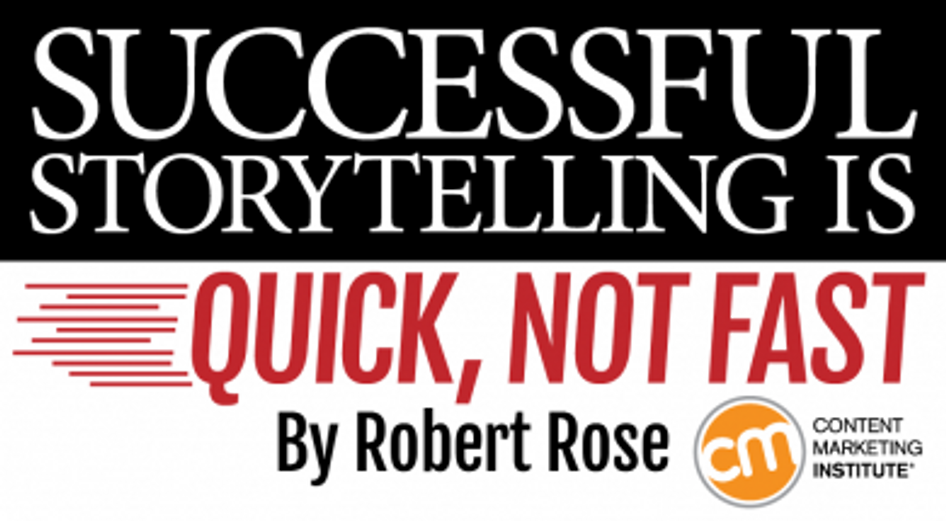Successful Storytelling Is Quick, Not Fast
- Fahad H

- Jun 10, 2015
- 3 min read

Agile is a tune to which all the marketing kids are dancing these days. But, interestingly, what gets lost in translation is the distinction between being fast and truly being agile.
The pressure to move faster and faster is everywhere. As Jim McGinnis, Vice President at Intuit, said in a recent interview:
The world has sped up in the past 20 years. The need to move fast is a requirement and yet, the rate of change is so rapid that it’s difficult for companies to stay nimble enough to keep pace with market demands.
But, of course, no sane person or team is able to keep up with this pace. The digital disruption has left many marketers struggling to rediscover the joy in the practice of marketing more broadly. An IBM C-Suite study found that 66% of CMOs feel pressure from their CEO or board to prove that marketing has value, and 60% say that CEOs are “turning up the heat.”
Quick, not fast
Quick is a measure of time; fast is a measure of speed.
Really, what McGinnis is speaking to in that interview – and what marketers are feeling – is not a pressure to move faster. When we move fast, we are much more prone to mistakes, and everything close to us turns into a blur.
Instead, the important strategy here is the ability to move quickly – to adapt to situations on the ground; and to move in and out of areas of engagement with a more fluid nature.
This is something we can take to our bosses. If we can start to reconfigure processes around managing content and digital assets across silos in a more fluid way – and in a way that helps us adapt more quickly – we can slow down the process and take more time to produce the high-quality assets that will move the business. This is how we’re seeing marketers rediscover the joy in marketing more broadly – and cool off that increasingly hot seat.
Collaborative, not protected content
Guess who also feels that “quick” fire directly under their feet? It’s the rank-and-file team members who have to make stuff work. That’s a huge challenge given that many marketing teams are separated from each other – working on their own projects, their own strategies, and sometimes with their own metrics that are sometimes (ironically) in competition with each other.
The teams at brands that are succeeding recognize that content collaboration and simplification are the critical pieces in managing digital content across all channels.
Today, creative and content managers in marketing must open their asset workflow beyond their internal enterprise. They need to collaborate – in real time – with external agencies, creative freelancers, and other enterprise systems that will manage and display the content to customers.
The critical factor here is agility. Marketers need to be able to customize the content and communicate it quickly to make better connections. That isn’t possible in the digital asset management of yesterday when assets were highly secure files protected from unauthorized users. Today, the creative marketing department lives in an on-demand world where marketing assets need to be accessed, iterated, published, and measured in real time.
Content marketing at scale
As content marketing becomes an increasingly important part of the overall strategic mix, marketers are feeling their chairs warm up as they have to learn how to become mass producers of rich media experiences.
We’ve seen this firsthand at CMI: Frustrated marketers looking to develop more creative and collaborative content management processes struggle to scale their content marketing. The fear of moving too slowly is causing marketers to do foolish things and to develop more media, more experiences, and more digital content at a faster rate, rather than optimize a set of well-defined digital experiences in an agile way.
So, what’s the answer? Well, high-performing brands are reorienting their digital media creation and management. They’re finding they must step away from “more and faster.” These marketers understand the difference between quick and fast and have developed a better process for creating a rich digital content experience.
Their new asset creation and management methodologies help their teams create and manage more impactful customer-centric experiences. As they evolve beyond old, stale hierarchies and governance-oriented processes, these companies are infusing these experiences intelligently into every part of the customer journey. Put simply, they are reorienting to agile asset management strategies – not faster strategies.
To learn more about agile and managing rich media assets, read the two newest white papers from CMI and Widen:
Your unique brand story is one of the five core elements for running successful, scalable content marketing operations. Read our 2016 Content Marketing Framework: 5 Building Blocks for Profitable, Scalable Operations for an overview of the full strategic blueprint.
Cover image by Joseph Kalinowski/Content Marketing Institute








Comments